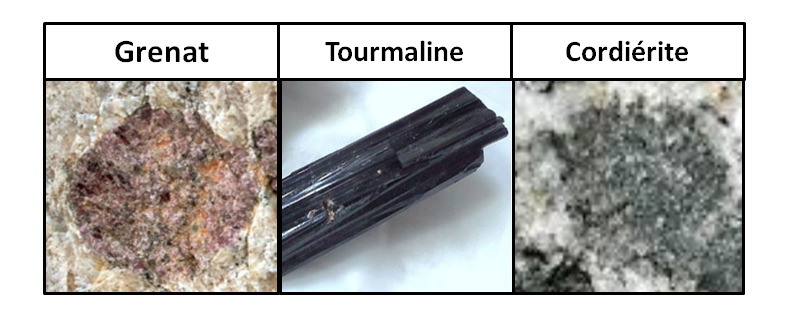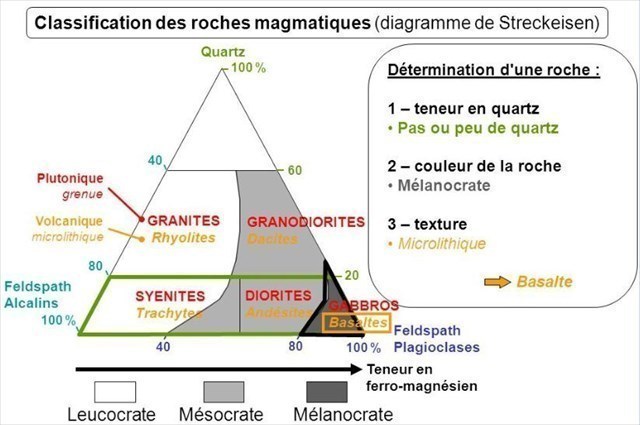
La Earhcache / The Earhcache
Le parc de la Roseraie est un des nombreux parcs de Nantes.
Si son substrat est une roche métamorphique, un micaschiste, l'aménagement du parc présente l'utilisation de nombreux types de roches dont du granite.
C'est le cas d'un petit enclos d'inspiration extrême-orientale qui permet une découverte en toute tranquillité des caractéristiques de cette roche, ou plutôt de ses déclinaisons
► Un granite, des granites ?
Le granite est une roche plutonique intrusive. Le magma mantellique pénètre progressivement dans la croûte terrestre et refroidit. Sa cristallisation se fait alors doucement, en profondeur.
Il présente plusieurs caractéristiques génériques qui le différencie des autres roches :
- Une nature entièrement cristalline.
- Une composition majoritairement QFM (voir plus loin).
- Une texture grenue (cristaux visibles à l’œil nu).
- Une absence d'orientation (litage).

Derrière ces traits communs, il existe une diversité de granites.
► La composition chimique, une roche QFM(+)
Un granite présente communément une composition chimique majoritaire de 3 minéraux qui peuvent se résumer en QFM :
- Q comme Quartz : translucide parfois transparent, ce minéral est gris sans facette.
- F comme Feldspath : ce minéral opaque avec facettes miroitantes a deux formes :
- une forme potassique (K+), orthose blanche ou rose selon la présence d’oxydes de fer.
- une forme sodique (Na+), albite blanc laiteux et d'aspect brillant.
- M comme Mica : ce minéral se présente en fines paillettes brillantes selon deux formes :
- la biotite, mica noir brillant de composition ferro-magnésienne.
- la muscovite, mica blanc brillant au soleil avec un aspect nacré.

A ces minéraux principaux peuvent s'ajouter des minéraux accessoires :
- Cordiérite : minéral polycristallin vert, parfois bleuté.
- Tourmaline : minéral noir formant des bâtonnets allongés de section triangulaire.
- Grenats : minéral rouge à système cristallin cubique.

► Texture et taille des cristaux
La texture d'une roche caractérise l'arrangement des cristaux et leur taille relative et absolue.
Dans une granite la taille des cristaux est directement liée à la vitesse de refroidissement. Plus le refroidissement est lent, plus les cristaux formés sont gros.
Le granite présente une texture générale grenue se déclinant en plusieurs formes :
- Texture grenue équante : les cristaux sont de même taille (de l'ordre du mm ou du cm).
- Texture grenue porphyroïde : de gros cristaux de taille centimétrique automorphes souvent préexistant dans le magma sont dispersés parmi des cristaux bien plus petits (de 5 à 10 fois).
- Texture aplitique : quartz et feldspaths seuls, en cristaux équigranulaires, formant un assemblage de taille millimétrique (roche hololeucocrate).
- Texture pegmatitique : minéraux de taille centimétrique à pluri-centimétrique, quartz et feldspath automorphes, avec ou sans micas.

► Coloration et composition d'un granite
La teinte d'une roche magmatique (et la taille de ces grains) permet de la caractériser selon le Diagramme de Streckeisen :
- une roche hololeucocrate est blanche, elle possède moins de 12,5% de ferromagnésiens.
- une roche leucocrate possède entre 12,5 et 37,5% de ferromagnésiens.
- une roche mésocrate possède entre 37,5 et 62,5% de ferromagnésiens.
- une roche est mélanocrate possède plus de 62,5% de ferromagnésiens.

La teinte dépend donc directement de la teneur en cristaux ferromagnésiens.
Dans le cadre du granite, le principal ferromagnésien est la biotite.
La proportion en biotite est variable, donnant une teinte hololeucocrate à quasiment mésocrate.

The Roseraie park is one of the many parks in Nantes.
If its substrate is a metamorphic rock, a mica schist, the development of the park presents the use of many types of rocks including granite.
This is the case of a small enclosure of Far Eastern inspiration which allows a peaceful discovery of the characteristics of this rock, or rather of its variations
► Granite, granites?
Granite is an intrusive plutonic rock. Mantle magma gradually penetrates the earth's crust and cools. Its crystallization is then done slowly, in depth.
It has several generic characteristics that differentiate it from other rocks:
- An entirely crystalline nature.
- A majority QFM composition (see below).
- A grainy texture (crystals visible to the naked eye).
- A lack of orientation (bedding).
Behind these common features, there is a diversity of granites.
► Chemical composition, a QFM rock (+)
A granite commonly has a majority chemical composition of 3 minerals which can be summarized in QFM:
- Q for Quartz: translucent sometimes transparent, this mineral is gray without facets.
- F for Feldspar: this opaque mineral with shimmering facets has two forms:
- a potassium form (K +), white or pink orthosis depending on the presence of iron oxides.
- a sodium form (Na +), milky white albite and shiny appearance.
- M like Mica: this mineral comes in fine shiny glitter in two forms:
- biotite, shiny black mica of ferro-magnesian composition.
- muscovite, white mica shining in the sun with a pearly appearance.
To these main minerals can be added accessory minerals:
- Cordierite: green polycrystalline mineral, sometimes bluish.
- Tourmaline: black mineral forming elongated sticks of triangular section.
- Garnets: red mineral with cubic crystal system.
► Texture and size of the crystals
The texture of a rock characterizes the arrangement of the crystals and their relative and absolute size.
In a granite the size of the crystals is directly related to the rate of cooling. The slower the cooling, the larger the crystals formed.
Granite has a general grainy texture available in several forms:
- Equant grainy texture: the crystals are the same size (of the order of mm or cm).
- Granular porphyroid texture: large automorphic centimeter-sized crystals often preexisting in the magma are dispersed among much smaller crystals (5 to 10 times).
- Aplitic texture: quartz and feldspars alone, in equigranular crystals, forming an assembly of millimeter size (hololeucocratic rock).
- Pegmatitic texture: minerals from centimeter to pluri-centimeter in size, quartz and automorphic feldspar, with or without micas.
► Coloring and composition of a granite
The tint of a magmatic rock (and the size of these grains) makes it possible to characterize it according to the Streckeisen Diagram:
- a hololeucocratic rock is white, it has less than 12.5% ferromagnesians.
- a leucocratic rock has between 12.5 and 37.5% ferromagnesians.
- a Mesocratic rock has between 37.5 and 62.5% ferromagnesians.
- a melanocratic rock has more than 62.5% ferromagnesians.
The shade therefore depends directly on the content of ferromagnesium crystals.
In the context of granite, the main ferromagnesium is biotite.
The proportion of biotite is variable, giving a hololeucocratic to almost mesocratic hue.
► Sources bibliographiques / Bibliographical sources
Les Questions / The Questions
Questions pour valider :"Un granite, des granites à la Roseraie ?"
Questions to validate: "Granite, granites at the Roseraie?"
Accès soumis à horaires / Access subject to timetables
Horaires du Parc de la Roseraie.
- Question 0 : Prenez une photo de vous ou d'un élément vous identifiant dans le parc de la Roseraie (mais pas les WPs).
Cette photo devra au choix nous être transmise avec les réponses ou être ajoutée à votre log.
-Question 0 : - Question 0: Take a photo of yourself or an identifying item in the park of the Roseraie (but not the WPs).
This photo must either be sent to us with the answers or added to your log.
Point 1 : N 47° 15.676 W 001° 32.032
Vous voici dans un petit espace d'inspiration extrême-orientale avec plusieurs éléments en granite (photo WP1).
Here you are in a small space of Far Eastern inspiration with several granite elements (photo WP1).

Le regard vers l'Erdre, étudions le granite A (zone bleue) formant le montant gauche de la partie supérieure du "puits".
Looking towards the Erdre, let's study the granite A (blue zone) forming the left upright of the upper part of the "well".
- Question 1 : Evaluez le pourcentage de minéraux ferromagnésiens et la teinte globale de la roche. Qualifiez la coloration de ce granite en utilisant le diagramme de Streckeisen.
- Question 1: Evaluate the percentage of ferromagnesian minerals and the overall hue of the rock. Qualify the coloring of this granite using the Streckeisen diagram.
- Question 2 : Observez la roche au soleil ou avec une lampe. Combien de cristaux pouvez-vous distinguer ? Décrivez les et nommez les.
- Question 2 : Observe the rock in the sun or with a lamp. How many crystals can you distinguish? Describe them and name them.
- Question 3 : Caractérisez la texture de ce granite et déduisez en ses conditions de cristallisation.
- Question 3 : Characterize the texture of this granite and deduce in its crystallization conditions.
Passons au granite B (zone rouge) formant le banc de l'autre côté de la petite table.
Let's move on to granite B (red zone) forming the bench on the other side of the small table.
- Question 4 : Observez la roche au soleil ou avec une lampe. Quelles différences au niveau de la composition cristalline avec le premier granite ?
- Question 4 : Observe the rock in the sun or with a lamp. What differences in terms of crystal composition with the first granite?
- Question 5 : Caractérisez la texture de ce granite et qualifiez ces cristaux. S'est-il formé dans les mêmes conditions que le premier granite ?
- Question 5 : Characterize the texture of this granite and qualify these crystals. Did it form under the same conditions as the first granite?
Point 2 : N 47° 15.674 W 001° 32.040
Longez le petit ruisseau en direction de l'Erdre. Juste avant un passage à gué avec des dalles, vous pouvez voir de gros blocs de roches sur la rive gauche.
Walk along the small stream towards the Erdre. Just before a ford with slabs, you can see large blocks of rock on the left bank.
- Question 6 : Décrivez ces blocs. Est-ce du granite ? Justifiez votre réponse.
- Question 6 : Describe these blocks. Is it granite? Justify your answer.
Vous pouvez vous loguer sans attendre notre confirmation,
mais vous devez nous envoyer les réponses par mail en même temps via notre profil (
fafahakkai).
S'il y a des problèmes avec vos réponses nous vous en ferons part.
Les logs enregistrés sans réponses seront supprimés.You can log this cache without waiting for our confirmation, but you must send us the answers by e-mail at the same time via our profile (fafahakkai).
If there is a problem with your answers we will notify you. The logs recorded without answers will be deleted.
Rappel concernant les « Earthcaches »: Il n'y a pas de conteneur à rechercher ni de logbook à renseigner. Il suffit de se rendre sur les lieux, de répondre aux questions ci-dessus et de nous renvoyer les réponses.
Reminder concerning "Earthcaches": there is neither a container to look for nor a logbook to sign. One need only go to the location, answer to the differents quiestions and send us the answers.